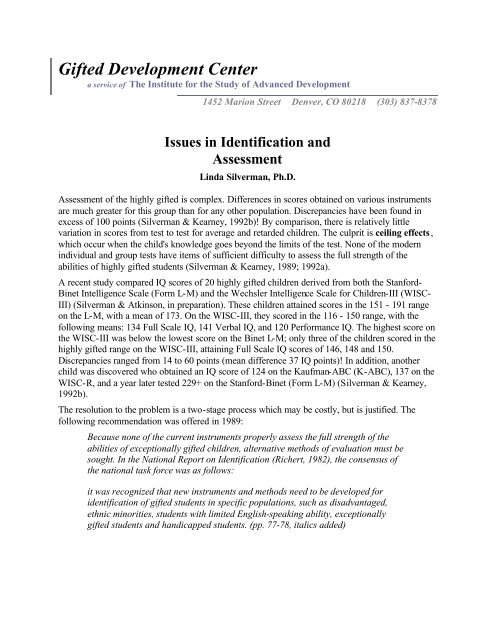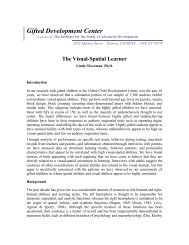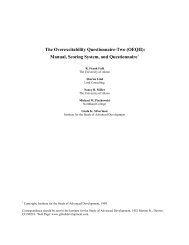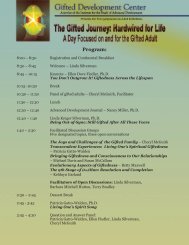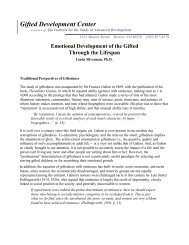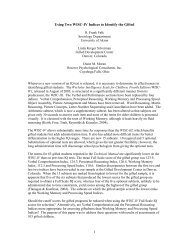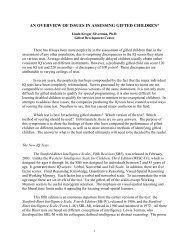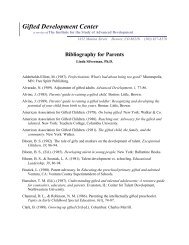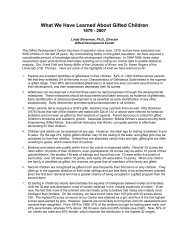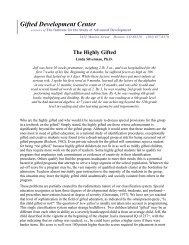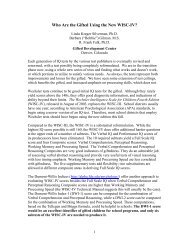Issues in Identification and Assessment - the Gifted Development ...
Issues in Identification and Assessment - the Gifted Development ...
Issues in Identification and Assessment - the Gifted Development ...
You also want an ePaper? Increase the reach of your titles
YUMPU automatically turns print PDFs into web optimized ePapers that Google loves.
<strong>Gifted</strong> <strong>Development</strong> Center<br />
a service of The Institute for <strong>the</strong> Study of Advanced <strong>Development</strong><br />
1452 Marion Street Denver, CO 80218 (303) 837-8378<br />
<strong>Issues</strong> <strong>in</strong> <strong>Identification</strong> <strong>and</strong><br />
<strong>Assessment</strong><br />
L<strong>in</strong>da Silverman, Ph.D.<br />
<strong>Assessment</strong> of <strong>the</strong> highly gifted is complex. Differences <strong>in</strong> scores obta<strong>in</strong>ed on various <strong>in</strong>struments<br />
are much greater for this group than for any o<strong>the</strong>r population. Discrepancies have been found <strong>in</strong><br />
excess of 100 po<strong>in</strong>ts (Silverman & Kearney, 1992b)! By comparison, <strong>the</strong>re is relatively little<br />
variation <strong>in</strong> scores from test to test for average <strong>and</strong> retarded children. The culprit is ceil<strong>in</strong>g effects,<br />
which occur when <strong>the</strong> child's knowledge goes beyond <strong>the</strong> limits of <strong>the</strong> test. None of <strong>the</strong> modern<br />
<strong>in</strong>dividual <strong>and</strong> group tests have items of sufficient difficulty to assess <strong>the</strong> full strength of <strong>the</strong><br />
abilities of highly gifted students (Silverman & Kearney, 1989; 1992a).<br />
A recent study compared IQ scores of 20 highly gifted children derived from both <strong>the</strong> Stanford-<br />
B<strong>in</strong>et Intelligence Scale (Form L-M) <strong>and</strong> <strong>the</strong> Wechsler Intelligence Scale for Children-III (WISC-<br />
III) (Silverman & Atk<strong>in</strong>son, <strong>in</strong> preparation). These children atta<strong>in</strong>ed scores <strong>in</strong> <strong>the</strong> 151 - 191 range<br />
on <strong>the</strong> L-M, with a mean of 173. On <strong>the</strong> WISC-III, <strong>the</strong>y scored <strong>in</strong> <strong>the</strong> 116 - 150 range, with <strong>the</strong><br />
follow<strong>in</strong>g means: 134 Full Scale IQ, 141 Verbal IQ, <strong>and</strong> 120 Performance IQ. The highest score on<br />
<strong>the</strong> WISC-III was below <strong>the</strong> lowest score on <strong>the</strong> B<strong>in</strong>et L-M; only three of <strong>the</strong> children scored <strong>in</strong> <strong>the</strong><br />
highly gifted range on <strong>the</strong> WISC-III, atta<strong>in</strong><strong>in</strong>g Full Scale IQ scores of 146, 148 <strong>and</strong> 150.<br />
Discrepancies ranged from 14 to 60 po<strong>in</strong>ts (mean difference 37 IQ po<strong>in</strong>ts)! In addition, ano<strong>the</strong>r<br />
child was discovered who obta<strong>in</strong>ed an IQ score of 124 on <strong>the</strong> Kaufman-ABC (K-ABC), 137 on <strong>the</strong><br />
WISC-R, <strong>and</strong> a year later tested 229+ on <strong>the</strong> Stanford-B<strong>in</strong>et (Form L-M) (Silverman & Kearney,<br />
1992b).<br />
The resolution to <strong>the</strong> problem is a two-stage process which may be costly, but is justified. The<br />
follow<strong>in</strong>g recommendation was offered <strong>in</strong> 1989:<br />
Because none of <strong>the</strong> current <strong>in</strong>struments properly assess <strong>the</strong> full strength of <strong>the</strong><br />
abilities of exceptionally gifted children, alternative methods of evaluation must be<br />
sought. In <strong>the</strong> National Report on <strong>Identification</strong> (Richert, 1982), <strong>the</strong> consensus of<br />
<strong>the</strong> national task force was as follows:<br />
it was recognized that new <strong>in</strong>struments <strong>and</strong> methods need to be developed for<br />
identification of gifted students <strong>in</strong> specific populations, such as disadvantaged,<br />
ethnic m<strong>in</strong>orities, students with limited English-speak<strong>in</strong>g ability, exceptionally<br />
gifted students <strong>and</strong> h<strong>and</strong>icapped students. (pp. 77-78, italics added)
<strong>Issues</strong> <strong>in</strong> <strong>Identification</strong> <strong>and</strong> <strong>Assessment</strong><br />
L<strong>in</strong>da Silverman, Ph.D.<br />
This recommendation is already be<strong>in</strong>g implemented with all of <strong>the</strong> specific<br />
populations listed except one--<strong>the</strong> exceptionally gifted. In this case, an old method<br />
of identification is more appropriate than newer methods. Our recommendation is<br />
that when a child obta<strong>in</strong>s three subtest scores at or near <strong>the</strong> ceil<strong>in</strong>g of any current<br />
<strong>in</strong>strument, he or she should be retested on <strong>the</strong> Stanford-B<strong>in</strong>et Form L-M.<br />
(Silverman & Kearney, 1989, p. 48)<br />
In <strong>the</strong> last few years, this recommendation has been adopted by several psychologists who assess<br />
highly gifted children. However, when <strong>the</strong>se criteria were applied to <strong>the</strong> data on <strong>the</strong> WISC-III, less<br />
than half of <strong>the</strong> highly gifted children <strong>in</strong> <strong>the</strong> sample were located (Silverman & Atk<strong>in</strong>son, <strong>in</strong><br />
preparation). Rimm <strong>and</strong> Lovance (1992) suggested that children be retested on <strong>the</strong> B<strong>in</strong>et L-M<br />
when <strong>the</strong>y atta<strong>in</strong>ed ceil<strong>in</strong>g level scores on two subtests.<br />
The Wechsler IQ tests are used for <strong>in</strong>itial test<strong>in</strong>g because <strong>the</strong> subtest scores are<br />
viewed as important for curriculum-related decisions. When students are at or near<br />
<strong>the</strong> ceil<strong>in</strong>g score on at least two subests, <strong>the</strong> Cl<strong>in</strong>ic recommends fur<strong>the</strong>r test<strong>in</strong>g<br />
us<strong>in</strong>g <strong>the</strong> Stanford-B<strong>in</strong>et, Form L-M. (Rimm & Lovance, 1992, p. 101)<br />
Us<strong>in</strong>g this criterion, 90 percent of <strong>the</strong> highly gifted sample were located. While <strong>the</strong> three-subtest<br />
rule appeared to be adequate for <strong>the</strong> WISC-R, it is recommended that two subtests of <strong>the</strong> WISC-III<br />
be used as <strong>the</strong> criterion for retest<strong>in</strong>g.<br />
The B<strong>in</strong>et (L-M) is also recommended if <strong>the</strong> child has a known eye-h<strong>and</strong> coord<strong>in</strong>ation problem, is<br />
highly reflective <strong>and</strong> a slow processor, or has difficulty with timed tests. The newer tests have<br />
substantially <strong>in</strong>creased <strong>the</strong> bonus po<strong>in</strong>ts for speed as a method of <strong>in</strong>creas<strong>in</strong>g reliability; if a child of<br />
12 solves every Performance item correctly on <strong>the</strong> WISC-III but gets no bonus po<strong>in</strong>ts for speed, he<br />
or she would score below average on every subtest (Kaufman, 1992).<br />
The biggest negatives for gifted assessment are <strong>the</strong> new emphasis on problemsolv<strong>in</strong>g<br />
speed on <strong>the</strong> WPPSI-R [<strong>and</strong>] <strong>the</strong> substantially <strong>in</strong>creased stress on<br />
performance time <strong>in</strong> <strong>the</strong> WISC-III compared to <strong>the</strong> WISC-R... The speed factor will<br />
penalize gifted children who are as reflective as <strong>the</strong>y are bright, or who tend to go<br />
slow for o<strong>the</strong>r non-cognitive reasons such as a mild coord<strong>in</strong>ation problem.<br />
(Kaufman, 1992, p. 158)<br />
The L-M is essentially untimed, <strong>and</strong> has few motoric dem<strong>and</strong>s. Therefore, it is a better <strong>in</strong>strument<br />
for children whose Verbal IQ scores are significantly higher (15 po<strong>in</strong>ts) than <strong>the</strong>ir Performance IQ<br />
scores. Thirteen of <strong>the</strong> 20 children <strong>in</strong> our sample had Verbal/Performance discrepancies of 15<br />
A-25; 2<br />
http://www.gifteddevelopment.com
<strong>Issues</strong> <strong>in</strong> <strong>Identification</strong> <strong>and</strong> <strong>Assessment</strong><br />
L<strong>in</strong>da Silverman, Ph.D.<br />
po<strong>in</strong>ts or greater (15 - 44 po<strong>in</strong>ts). One child who scored 164 on <strong>the</strong> B<strong>in</strong>et L-M obta<strong>in</strong>ed only a 99<br />
on <strong>the</strong> Performance section of <strong>the</strong> WISC-III (Silverman & Atk<strong>in</strong>son, <strong>in</strong> preparation).<br />
Reservations psychologists might have about us<strong>in</strong>g <strong>the</strong> old Stanford-B<strong>in</strong>et are discussed elsewhere<br />
(Silverman & Kearney, 1992a; 1992b). However, it is important to note that it is not "unethical" to<br />
use a dated test: Stanley E. Jones, Director of <strong>the</strong> Office of Ethics for <strong>the</strong> American Psychological<br />
Association, writes:<br />
It would not be my read<strong>in</strong>g that Pr<strong>in</strong>ciple 2.9 would prohibit <strong>the</strong> use of any test for<br />
a purpose that can be defended. It does make it <strong>the</strong> responsibility of <strong>the</strong><br />
psychologist to provide such a defense when us<strong>in</strong>g tests which are not obviously<br />
current. (personal communication to Sylvia Rimm, November 25, 1991)<br />
*Note: This material was excerpted from "Highly <strong>Gifted</strong> Children," by L<strong>in</strong>da Kreger Silverman, <strong>in</strong> J. Genshaft,<br />
M. Bireley, & C. L. Holl<strong>in</strong>ger (Eds.) (1995). Serv<strong>in</strong>g gifted <strong>and</strong> talented students: A resource for school personnel<br />
(pp. 217-240). Aust<strong>in</strong>, TX: Pro-Ed.<br />
REFERENCES<br />
Kaufman, A. S. (1992). Evaluation of <strong>the</strong> WISC-III <strong>and</strong> WPPSI-R for gifted children. Roeper Review, 14, 154-158.<br />
Richert, E. S., with Alv<strong>in</strong>o, J. J., & McDonnel, R. C. (1982). National report on identification: <strong>Assessment</strong> <strong>and</strong><br />
recommendations for comprehensive identification of gifted <strong>and</strong> talented youth. Sewell, NJ: Educational<br />
Improvement Center-South.<br />
Rimm, S. B. , & Lovance, K. J. (1992). The use of subject <strong>and</strong> grade skipp<strong>in</strong>g for <strong>the</strong> prevention <strong>and</strong> reversal of<br />
underachievement. <strong>Gifted</strong> Child Quarterly, 36(2), 100-105.<br />
Silverman, L. K., & Atk<strong>in</strong>son, D. R. (<strong>in</strong> preparation). Comparisons of <strong>the</strong> highly gifted on <strong>the</strong> WISC-III <strong>and</strong> <strong>the</strong><br />
Stanford-B<strong>in</strong>et Form L-M.<br />
Silverman, L. K., & Kearney, K. (1989). Parents of <strong>the</strong> extraord<strong>in</strong>arily gifted. Advanced <strong>Development</strong>, 1, 41-56.<br />
Silverman, L. K., & Kearney, K. (1992a). The case for <strong>the</strong> Stanford-B<strong>in</strong>et L-M as a supplemental test. Roeper Review,<br />
15, 34-37.<br />
Silverman, L. K., & Kearney, K. (1992b). Don't throw away <strong>the</strong> old B<strong>in</strong>et. Presented at <strong>the</strong> 39th annual convention of<br />
<strong>the</strong> National Association for <strong>Gifted</strong> Children, Los Angeles, CA, November 6, 1992. [Appeared <strong>in</strong> part <strong>in</strong><br />
Underst<strong>and</strong><strong>in</strong>g Our <strong>Gifted</strong>, 4(4), 1, 8-10.]<br />
L<strong>in</strong>da Silverman, Ph.D., is a licensed psychologist<br />
<strong>and</strong> Director of <strong>the</strong> <strong>Gifted</strong> <strong>Development</strong> Center <strong>in</strong> Denver, Colorado.<br />
A-25; 3<br />
http://www.gifteddevelopment.com


